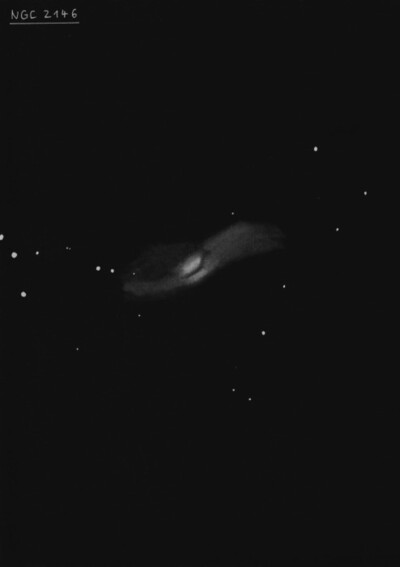
Friedrich August Winnecke discovered NGC 2146 = T 1-18 in 1876 using a 6.5-inch comet seeker at the Strasbourg Observatory. It was independently discovered by Wilhelm Tempel the same year and by Johann Palisa (AN 2732). This is one of 3 galaxies discovered by Winnecke, along with NGC 2276 and NGC 4760. In 1920, based on a photograph taken with the Mt. Wilson 60", Francis Pease described "the nucleus lies a little S of the center of this mass; the nebulosity is brightest around the nucleus. Superimposed on this bright mass is a dark marking in the form of a hand, with four talon-like figers stretching south-preceding and with three stars standing out upon it." This must be the source of the nickname "Dusty Hand Galaxy".
As there is no candidate for a previous interaction (creating the disrupted appearance and nuclear starburst), it has been proposed that NGC 2146 is a far-evolved merger.
300/350mm - 13.1" (1/18/85): fairly bright, fairly large, very elongated 3:1 NW-SE, bright core. A mag 11 double at 30" separation is just off the SE end. A few brighter mag 10-11 stars are 6' E. NGC 2146A lies 19' ENE.
600/800mm - 24" (12/28/13): this highly distorted galaxy was observed at 260x. The galaxy appeared very bright, very large, elongated 5:2 NW-SE, ~5'x2', with a very asymmetric structure. It contains a very bright, elongated core, ~1.2'x0.5' NW-SE, but with no distinct nucleus. A low contrast dust lane cuts through the core unevenly, with the main section on the north side, so the lane initially appears to run parallel to the core on the southwest side. But a fainter, elongated section of the core extending NW-SE is just beyond the dust lane on the southwest side. To the southeast of the core, the outer halo is diffuse, with a low surface brightness and is not aligned with the major axis of the core, extending more towards the east. On the NW side of the core, the halo has a higher and irregular surface brightness with a slightly brighter curving arc (arm) along its eastern side.
900/1200mm - 48" (10/29/16): at 488x, the "Dusty Hand" galaxy has an unusual, highly disrupted appearance. The very bright core is large and elongated NW-SE with a small, intense nucleus. A prominent, fairly wide dust lane slices through the center with the brightest part of the core roughly parallel on the north side. A small portion of the core is on the south side of the lane. These features give rise to the "Dusty Hand" nickname. On the southeast side a fairly prominent "arm" or plume (part of a merged companion?) extends generally east beyond a mag 14.5 star 2' ESE of center. The halo is very diffuse to the north of this arm. At the northwest end of the a galaxy a very faint "arm" curls sharply clockwise and with careful viewing a very low surface brightness plume (detached from the central portion) extends south on the west side. On deep images these arms and plumes seem to be a single tidal structure or stream that wraps around the galaxy.
Notes by Steve Gottlieb